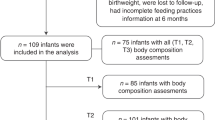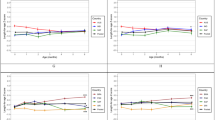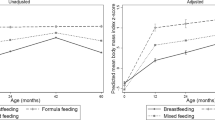Abstract
Background/Objective
High magnitude of adiposity peak and early adiposity rebound are early risk markers of later obesity. Infant diet represents one of the main modifiable determinants of early growth. This study aimed to investigate the association between infant feeding practices and age and magnitude of adiposity peak and rebound.
Subjects/Methods
Analyses were based on data from the French EDEN mother–child cohort. Data on breastfeeding and complementary feeding were collected at birth and 4, 8, and 12 months. From clinical examinations and measurements collected in the child’s health booklet up to 12 years, individual growth curves were modeled, and ages and magnitudes of adiposity peak and rebound were estimated. Associations between infant feeding practices and growth were investigated by multivariable linear regression in children after testing a child-sex interaction.
Results
In the studied population (n = 1225), adiposity peak occurred at a mean of 9.9 ± 2 months and adiposity rebound at 5.5 ± 1.4 years. Associations between infant feeding practices and adiposity peak or rebound were moderated by child sex. For girls, each additional month of breastfeeding was related to a 2-day increase in the age at adiposity peak (p < 0.001), and an 18-day increase in the age at adiposity peak (p = 0.004). Whereas for boys, each additional month for the age at complementary food introduction was associated with a 29-day increase in the age at adiposity rebound (p = 0.02). For boys, long breastfeeding duration was only related to reduced body mass index at adiposity peak.
Conclusions
Child sex has a moderating effect on the association between infant feeding practices and adiposity peak or rebound. The well-known association between breastfeeding duration and early growth seems stronger in girls than boys. The association found for complementary feeding in boys may give new insights into preventing obesity.
This is a preview of subscription content, access via your institution
Access options
Subscribe to this journal
Receive 12 print issues and online access
$259.00 per year
only $21.58 per issue
Buy this article
- Purchase on Springer Link
- Instant access to full article PDF
Prices may be subject to local taxes which are calculated during checkout

Similar content being viewed by others
References
Baird J, Fisher D, Lucas P, Kleijnen J, Roberts H, Law C. Being big or growing fast: systematic review of size and growth in infancy and later obesity. BMJ. 2005;331:929.
Brisbois TD, Farmer AP, McCargar LJ. Early markers of adult obesity: a review. Obes Rev. 2012;13:347–67.
Monasta L, Batty GD, Cattaneo A, Lutje V, Ronfani L, Van Lenthe FJ, et al. Early-life determinants of overweight and obesity: a review of systematic reviews. Obes Rev. 2010;11:695–708.
Rolland-Cachera MF, Deheeger M, Bellisle F, Sempe M, Guilloud-Bataille M, Patois E. Adiposity rebound in children: a simple indicator for predicting obesity. Am J Clin Nutr. 1984;39:129–35.
Williams SM, Goulding A. Patterns of growth associated with the timing of adiposity rebound. Obesity. 2009;17:335–41.
Rolland-Cachera MF, Cole TJ. Does the age at adiposity rebound reflect a critical period? Pediatr Obes. 2019;14. https://doi.org/10.1111/ijpo.12467.
Taylor RW, Grant AM, Goulding A, Williams SM. Early adiposity rebound: review of papers linking this to subsequent obesity in children and adults. Curr Opin Clin Nutr Metab Care. 2005;8:607–12.
Gonzalez L, Corvalan C, Pereira A, Kain J, Garmendia ML, Uauy R. Early adiposity rebound is associated with metabolic risk in 7-year-old children. Int J Obes. 2014;38:1299–304.
Hof MH, Vrijkotte TG, de Hoog ML, van Eijsden M, Zwinderman AH. Association between infancy BMI peak and body composition and blood pressure at age 5-6 years. PLoS One. 2013;8:e80517.
Silverwood RJ, De Stavola BL, Cole TJ, Leon DA. BMI peak in infancy as a predictor for later BMI in the Uppsala Family Study. Int J Obes. 2009;33:929–37.
Aris IM, Bernard JY, Chen LW, Tint MT, Pang WW, Lim WY, et al. Infant body mass index peak and early childhood cardio-metabolic risk markers in a multi-ethnic Asian birth cohort. Int J Epidemiol. 2017;46:513–25.
Jensen SM, Ritz C, Ejlerskov KT, Molgaard C, Michaelsen KF. Infant BMI peak, breastfeeding, and body composition at age 3 y. Am J Clin Nutr. 2015;101:319–25.
Sovio U, Kaakinen M, Tzoulaki I, Das S, Ruokonen A, Pouta A, et al. How do changes in body mass index in infancy and childhood associate with cardiometabolic profile in adulthood? Findings from the Northern Finland Birth Cohort 1966 Study. Int J Obes. 2014;38:53–9.
Pearce J, Taylor MA, Langley-Evans SC. Timing of the introduction of complementary feeding and risk of childhood obesity: a systematic review. Int J Obes. 2013;37:1295–306.
Horta BL, Loret de Mola C, Victora CG. Long-term consequences of breastfeeding on cholesterol, obesity, systolic blood pressure and type 2 diabetes: a systematic review and meta-analysis. Acta Paediatr. 2015;104:30–7.
Patro-Golab B, Zalewski BM, Kolodziej M, Kouwenhoven S, Poston L, Godfrey KM, et al. Nutritional interventions or exposures in infants and children aged up to 3 years and their effects on subsequent risk of overweight, obesity and body fat: a systematic review of systematic reviews. Obes Rev. 2016;17:1245–57.
Patro-Golab B, Zalewski BM, Polaczek A, Szajewska H. Duration of breastfeeding and early growth: a systematic review of current evidence. Breastfeed Med. 2019;14:218–29.
Dorosty AR, Emmett PM, Cowin S, Reilly JJ. Factors associated with early adiposity rebound. ALSPAC Study Team. Pediatrics. 2000;105:1115–8.
Gunther AL, Buyken AE, Kroke A. The influence of habitual protein intake in early childhood on BMI and age at adiposity rebound: results from the DONALD Study. Int J Obes. 2006;30:1072–9.
Chivers P, Hands B, Parker H, Bulsara M, Beilin LJ, Kendall GE, et al. Body mass index, adiposity rebound and early feeding in a longitudinal cohort (Raine Study). Int J Obes. 2010;34:1169–76.
Heude B, Forhan A, Slama R, Douhaud L, Bedel S, Saurel-Cubizolles MJ, et al. Cohort Profile: The EDEN mother-child cohort on the prenatal and early postnatal determinants of child health and development. Int J Epidemiol. 2016;45:353–63.
Bonet M, Marchand L, Kaminski M, Fohran A, Betoko A, Charles MA, et al. Breastfeeding duration, social and occupational characteristics of mothers in the French ‘EDEN mother-child’ cohort. Matern Child Health J. 2013;17:714–22.
Betoko A, Charles MA, Hankard R, Forhan A, Bonet M, Saurel-Cubizolles MJ, et al. Infant feeding patterns over the first year of life: influence of family characteristics. Eur J Clin Nutr. 2013;67:631–7.
[Le guide nutrition de la naissance à trois ans]. Agence française de sécurité sanitaire des aliments, 2005.
Scott JA, Binns CW, Graham KI, Oddy WH. Predictors of the early introduction of solid foods in infants: results of a cohort study. BMC Pediatr. 2009;9:60.
Bournez M, Ksiazek E, Wagner S, Kersuzan C, Tichit C, Gojard S, et al. Factors associated with the introduction of complementary feeding in the French ELFE cohort study. Matern Child Nutr. 2018;14:e12536.
Betoko A, Lioret S, Heude B, Hankard R, Carles S, Forhan A, et al. Influence of infant feeding patterns over the first year of life on growth from birth to 5 years. Pediatr Obes. 2017;12:94–101.
Lioret S, Betoko A, Forhan A, Charles MA, Heude B, de Lauzon-Guillain B, et al. Dietary patterns track from infancy to preschool age: cross-sectional and longitudinal perspectives. J Nutr. 2015;145:775–82.
Botton J, Scherdel P, Regnault N, Heude B, Charles MA. Group EM-CCS. Postnatal weight and height growth modeling and prediction of body mass index as a function of time for the study of growth determinants. Ann Nutr Metab. 2014;65:156–66.
Sovio U, Mook-Kanamori DO, Warrington NM, Lawrence R, Briollais L, Palmer CN, et al. Association between common variation at the FTO locus and changes in body mass index from infancy to late childhood: the complex nature of genetic association through growth and development. PLoS Genet. 2011;7:e1001307.
Ciss‚ AH, Lioret S, de Lauzon-Guillain B, Forhan A, Ong KK, Charles MA. et al. Association between perinatal factors, genetic susceptibility to obesity and age at adiposity rebound in children of the EDEN mother-child cohort. Int J Obes. 2021;45:1802–10.
Mamelle N, Munoz F, Grandjean H. Fetal growth from the AUDIPOG study. I. Establishment of reference curves. J Gynecol Obstet Biol Reprod (Paris). 1996;25:61–70.
Ferguson KD, McCann M, Katikireddi SV, Thomson H, Green MJ, Smith DJ, et al. Evidence synthesis for constructing directed acyclic graphs (ESC-DAGs): a novel and systematic method for building directed acyclic graphs. Int J Epidemiol. 2020;49:322–9.
Eekhout I, van de Wiel MA, Heymans MW. Methods for significance testing of categorical covariates in logistic regression models after multiple imputation: power and applicability analysis. BMC Med Res Methodol. 2017;17:129.
Institute S SAS 9.4 Output delivery system: User’s guide: SAS Institute; 2014.
Rolland-Cachera MF, Deheeger M, Akrout M, Bellisle F. Influence of macronutrients on adiposity development: a follow up study of nutrition and growth from 10 months to 8 years of age. Int J Obes Relat Metab Disord. 1995;19:573–8.
Aris IM, Rifas-Shiman SL, Li LJ, Kleinman K, Coull BA, Gold DR, et al. Pre-, Perinatal, and Parental Predictors of Body Mass Index Trajectory Milestones. J Pediatr. 2018;201:69–77.e8.
Wu Y, Lye S, Dennis CL, Briollais L. Exclusive breastfeeding can attenuate body-mass-index increase among genetically susceptible children: A longitudinal study from the ALSPAC cohort. PLoS Genet. 2020;16:e1008790.
Durmus B, van Rossem L, Duijts L, Arends LR, Raat H, Moll HA, et al. Breast-feeding and growth in children until the age of 3 years: the Generation R Study. Br J Nutr. 2011;105:1704–11.
de Hoog ML, van Eijsden M, Stronks K, Gemke RJ, Vrijkotte TG. The role of infant feeding practices in the explanation for ethnic differences in infant growth: the Amsterdam Born Children and their Development study. Br J Nutr. 2011;106:1592–601.
Oddy WH, Mori TA, Huang RC, Marsh JA, Pennell CE, Chivers PT, et al. Early infant feeding and adiposity risk: from infancy to adulthood. Ann Nutr Metab. 2014;64:262–70.
Rogers SL, Blissett J. Breastfeeding duration and its relation to weight gain, eating behaviours and positive maternal feeding practices in infancy. Appetite. 2017;108:399–406.
Dewey KG, Peerson JM, Brown KH, Krebs NF, Michaelsen KF, Persson LA, et al. Growth of breast-fed infants deviates from current reference data: a pooled analysis of US, Canadian, and European data sets. World Health Organization Working Group on Infant Growth. Pediatrics. 1995;96:495–503.
Rolland-Cachera MF, Deheeger M, Maillot M, Bellisle F. Early adiposity rebound: causes and consequences for obesity in children and adults. Int J Obes (Lond). 2006;30:S11–7.
Galante L, Milan AM, Reynolds CM, Cameron-Smith D, Vickers MH, Pundir S. Sex-specific human milk composition: the role of infant sex in determining early life nutrition. Nutrients. 2018;10:1194.
Quesnel L, MacKay A, Forsyth D, Nicholas K, Festa‐Bianchet M. Size, season and offspring sex affect milk composition and juvenile survival in wild kangaroos. Journal of Zoology. 2017;302:252–62.
Robert KA, Braun S. Milk composition during lactation suggests a mechanism for male biased allocation of maternal resources in the tammar wallaby (Macropus eugenii). PLoS One. 2012;7:e51099.
Landete-Castillejos T, García A, López-Serrano FR, Gallego L. Maternal quality and differences in milk production and composition for male and female Iberian red deer calves (Cervus elaphus hispanicus). Behavioral Ecology and Sociobiology. 2005;57:267–74.
Gluckman PD, Hanson MA. Developmental and epigenetic pathways to obesity: an evolutionary-developmental perspective. Int J Obes. 2008;32:S62–71.
Gluckman PD, Hanson MA, Low FM. Evolutionary and developmental mismatches are consequences of adaptive developmental plasticity in humans and have implications for later disease risk. Philos Trans R Soc Lond B Biol Sci. 2019;374:20180109.
Godfrey KM, Lillycrop KA, Burdge GC, Gluckman PD, Hanson MA. Epigenetic mechanisms and the mismatch concept of the developmental origins of health and disease. Pediatr Res. 2007;61:5R–10R.
Dulloo AG, Jacquet J, Seydoux J, Montani JP. The thrifty ‘catch-up fat’ phenotype: its impact on insulin sensitivity during growth trajectories to obesity and metabolic syndrome. Int J Obes. 2006;30:S23–35.
Kramer MS, Moodie EE, Dahhou M, Platt RW. Breastfeeding and infant size: evidence of reverse causality. Am J Epidemiol. 2011;173:978–83.
Vail B, Prentice P, Dunger DB, Hughes IA, Acerini CL, Ong KK. Age at Weaning and Infant Growth: Primary Analysis and Systematic Review. J Pediatr. 2015;167:317–24 e1.
Wright CM, Parkinson KN, Drewett RF. Why are babies weaned early? Data from a prospective population based cohort study. Arch Dis Child. 2004;89:813–6.
Eriksen KG, Johnson W, Sonko B, Prentice AM, Darboe MK, Moore SE. Following the World Health Organization’s Recommendation of Exclusive Breastfeeding to 6 Months of Age Does Not Impact the Growth of Rural Gambian Infants. J Nutr. 2017;147:248–55.
Acknowledgements
Members of the EDEN Mother–Child Cohort Study Group I AnnesiMaesano, JY Bernard, J Botton, MA Charles, P Dargent-Molina, B de Lauzon-Guillain, P Ducimetière, M de Agostini, B Foliguet, A Forhan, X Fritel, A Germa, V Goua, R Hankard, B Heude, M Kaminski, B Larroque†, N Lelong, J Lepeule, G Magnin, L Marchand, C Nabet, F Pierre, R Slama, MJ Saurel-Cubizolles, M Schweitzer and O Thiebaugeorges.
Funding
The EDEN study is supported by the Fondation pour la Recherche Médicale (FRM), French Ministry of Research: Federative Research Institutes and Cohort Program, INSERM Human Nutrition National Research Program, and Diabetes National Research Program (by a collaboration with the French Association of Diabetic Patients [AFD]), French Ministry of Health, French Agency for Environment Security (AFSSET), French National Institute for Population Health Surveillance (InVS), Paris‐Sud University, French National Institute for Health Education (INPES), Nestlé, Mutuelle Générale de l’Education Nationale (MGEN), French‐speaking Association for the Study of Diabetes and Metabolism (ALFEDIAM), National Agency for Research (ANR non‐thematic programme), and National Institute for Research in Public Health (IRESP: TGIR 2008 cohort in health programme). The study was funded by an ANR grant (InfaDiet project, grant no.: ANR-19-CE36-0008). This research benefited from the assistance of the funding partners of the IReSP within the framework of the 2016 General call for projects—Prevention topic (HEUDE-AAP16-PREV-24). The funders had no role in the study design, data collection and analysis, decision to publish, or preparation of the manuscript.
Author information
Authors and Affiliations
Contributions
AC: conceptualization, formal analysis, writing-original draft. AHC: formal analysis, writing—review and editing. SL: writing—review and editing, funding acquisition. JYB: writing—review and editing, funding acquisition. MAC: writing—review and editing, supervision, funding acquisition. BH: writing—review and editing, supervision, funding acquisition, project administration. BLG: writing—review and editing, supervision, funding acquisition, project administration, validation.
Corresponding author
Ethics declarations
Competing interests
The authors declare no competing interests.
Additional information
Publisher’s note Springer Nature remains neutral with regard to jurisdictional claims in published maps and institutional affiliations.
Supplementary information
Rights and permissions
About this article
Cite this article
Camier, A., Cissé, A.H., Lioret, S. et al. Infant feeding practices associated with adiposity peak and rebound in the EDEN mother–child cohort. Int J Obes 46, 809–816 (2022). https://doi.org/10.1038/s41366-021-01059-y
Received:
Revised:
Accepted:
Published:
Issue Date:
DOI: https://doi.org/10.1038/s41366-021-01059-y



